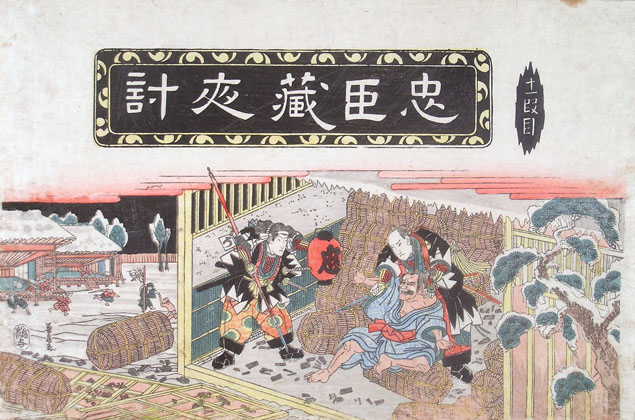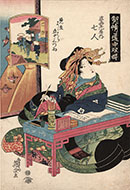(1790 - 1848)
CHUSHINGURA, ACT XI, THE CAPTURE OF KO NO MORONO , c. 1830s
Colour woodblock print, c. 1830s. Signed Eisen ga. Mark of the publisher Soshuya Yohei. Very good impression and colour; minor faults, generally in very good condition. Oban yoko-e 259 x 387 mm.
Of the numerous dramas performed in the kabuki theater, by far the most popular as a subject for colour prints was the Chushingura, or the Loyal League of Forty-seven Ronin. The drama is founded on an historical event which took place in 1701, and relates how a certain noble, Asano Takumi-no-Kami, was so persistently insulted by another noble, Kira Kotsuke-no-Suke, his instructor in Court etiquette, that he was at last compelled to draw his sword upon his tormentor in the latter's palace. Such an offense (drawing his weapon within the Court precincts) was punishable by death, and Takumi-no-Kami was condemned to commit seppuku. The revenge-story of his faithful retainers who so had become masterless samurai, or ronin, is the subject of the play.
Eisen was son of a samurai, Ikeda Masahei Shigeharu, a talented calligrapher. After his parents died he was forced to become a ronin to support his younger sisters. At one time a Kabuki playwright using the name Chiyoda Saishi, and about this time lodged with the family of Kikukawa Eizan and studied painting with Eizan's father, Eiji. In later years a prolific author of popular literature and, in 1833, he compiled a manuscript which was a reworking of the biographies of Ukiyo-e artists. He studied also with the minor Kano painter Hakkeisai and with Kikukawa Eizan. From the late Bunka era (1804-18) onwards he designed many illustrations for the various genres of popular literature as well as surimono and produced a large output of single-sheet prints of women, including some fine bust portraits. He was also author off many shunga and contributed twenty-four designs in a Kano-influenced style to the landscape series Sixty-nine Stations of the Kisokaido (late 1830s) designed with Hiroshige.

